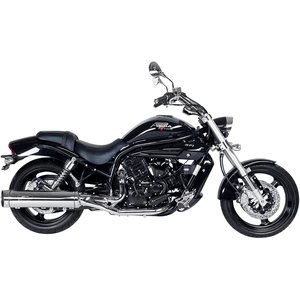Hyosung GV 650 [2011-2017]: The V-Twin Cruiser That Punches Above Its Weight
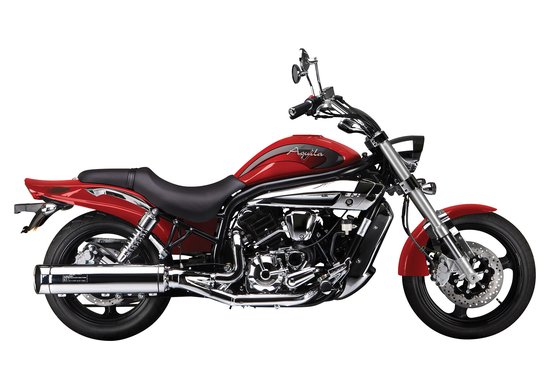
Introduction
The Hyosung GV 650, produced between 2011 and 2017, is a motorcycle that defies expectations. Often overshadowed by Japanese and American cruisers, this South Korean V-twin offers a compelling blend of sporty performance, cruiser aesthetics, and surprising technical sophistication. With its liquid-cooled 647cc engine, inverted front forks, and belt final drive, the GV 650 carves out a unique niche in the middleweight cruiser segment. After spending a week with a well-maintained 2015 Aquila Pro model, it’s clear this bike deserves more attention than it typically receives.
Design & Styling: Modern Meets Muscle
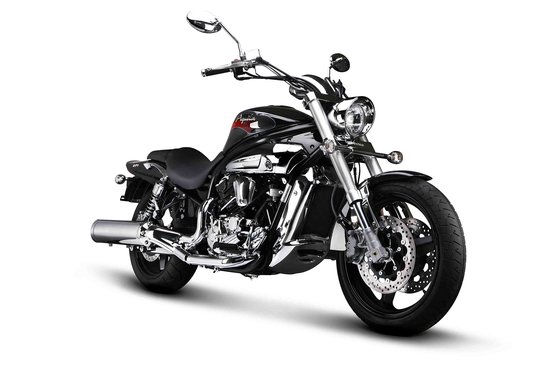
Hyosung took a bold approach with the GV 650’s design language. The 41mm USD forks immediately catch the eye, a rarity in cruisers that typically favor traditional telescopic forks. The teardrop fuel tank (16L capacity / 4.23 US gal) flows into a stepped seat with a 705mm (27.8") height that accommodates riders of various sizes. Chrome accents on the exhausts and engine guards contrast nicely with matte black finishes, while the LED tail light adds a modern touch.
The digital-analog instrument cluster deserves special mention. Unlike the basic gauges found on many cruisers, the GV 650’s VFD display provides crisp readouts for speed, fuel, and trip data. At night, the blue backlighting creates a premium cockpit feel that rivals bikes costing twice as much.
Riding Experience: Sporty Soul in a Cruiser Body
Engine & Performance
The 647cc 90° V-twin is the star of the show. Producing 79 HP (57.7 kW) at 9,000 RPM and 67 Nm (49.4 lb-ft) of torque at 7,250 RPM, it delivers power with a character that splits the difference between a Harley’s low-end grunt and a sportbike’s rev-happy nature. Cold starts require a few seconds of choke (idle settles at 1,400-1,500 RPM), but once warm, the fuel-injected engine responds crisply.
The 5-speed transmission shifts with positive clicks, though the cable-operated clutch requires firm lever pulls in stop-and-go traffic. Where this setup shines is highway cruising – the belt final drive (a maintenance advantage over chains) transmits power smoothly at 110 km/h (68 mph), with plenty in reserve for passing maneuvers.
Chassis & Handling
Hyosung’s engineers clearly had sport riding in mind. The inverted forks and preload-adjustable rear shocks provide 160mm (6.3") of ground clearance – generous for a cruiser. Combined with the 18" front/17" rear wheel setup (120/70 and 180/55 tires respectively), the GV 650 leans into corners with unexpected enthusiasm.
At 232 kg (511 lbs) wet, it’s no lightweight, but the weight distribution masks this heft once moving. The 1,700mm (66.9") wheelbase offers stability at speed without feeling cumbersome in city riding. Braking from the dual 300mm front discs inspires confidence, though pad upgrades (available at MOTOPARTS.store) can sharpen response.
Comfort & Practicality
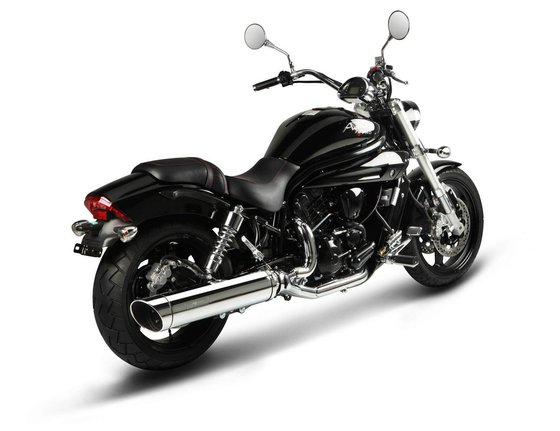
The rider triangle positions feet slightly forward but not stretched out, with handlebars that require only a mild lean. Over a 320km (200-mile) test day, the seat proved firm but supportive – an aftermarket gel pad could enhance long-distance comfort. Wind protection from the small flyscreen is minimal; riders planning extended highway miles might consider a taller windshield from our accessories range.
Storage options are typical cruiser-class – i.e., nonexistent without adding saddlebags. The 16L fuel tank provides a 280-320km (174-199-mile) range, depending on riding style. For two-up riding, the passenger seat accommodates adults comfortably, though the rear suspension (preload-adjustable via wrench) benefits from stiffening when carrying a passenger.
Competition: How It Stacks Up
The GV 650’s closest rivals include:
-
Suzuki Boulevard S40 (652cc):
Lighter at 179kg (395 lbs) but air-cooled and carbureted. The Hyosung offers 50% more power and modern fuel injection. -
Kawasaki Vulcan S (649cc):
A formidable opponent with ergonomic adjustability. The Vulcan’s parallel twin is smoother, but the GV 650’s V-twin delivers more visceral character. -
Honda Shadow Phantom (745cc):
Larger displacement but only 44HP. The Honda wins on brand reputation, while the Hyosung counters with superior suspension and braking components.
Where the GV 650 truly shines is value proposition. It combines features rarely seen together in this class: liquid cooling, USD forks, and a 180-section rear tire. The trade-off comes in fit-and-finish details – some switchgear feels plasticky, and chrome parts require diligent care to prevent pitting.
Maintenance: Keeping Your GV 650 in Peak Form

Critical Service Intervals
-
Oil Changes: Every 5,000km (3,100 miles)
Requires 3.2L of SAE 10W-40 (API SL or newer). Consider MOTOPARTS.store’s synthetic blend for improved high-temperature protection. -
Valve Adjustments: Every 12,000km (7,500 miles)
Cold clearance specs:
Intake: 0.10-0.20mm (0.004-0.008")
Exhaust: 0.20-0.30mm (0.008-0.012") -
Cooling System:
Replace coolant (1.6L capacity) every 2 years. Use ethylene glycol-based mix rated for -35°C.
Common Wear Items
-
Spark Plugs: NGK CR8E (standard) or CR8EIX iridium upgrade
Gap: 0.6mm (0.024") -
Brake Fluid: DOT 4, flush biennially
MOTOPARTS.store’s high-performance fluid reduces fade during aggressive riding. -
Tire Pressures:
Front: 2.2-2.4 bar (32-35 psi)
Rear: 2.4-2.6 bar (35-38 psi)
Consider Metzeler Cruisetec tires for improved wet grip.
Troubleshooting Tips
- Cold Start Issues: Clean the idle air control valve annually.
- Electrical Gremlins: Upgrade to a MOSFET regulator/rectifier (available in-store).
- Belt Longevity: Inspect every 8,000km (5,000 miles). Avoid pressure washing the drivetrain.
Owner Modifications: Unleashing Potential
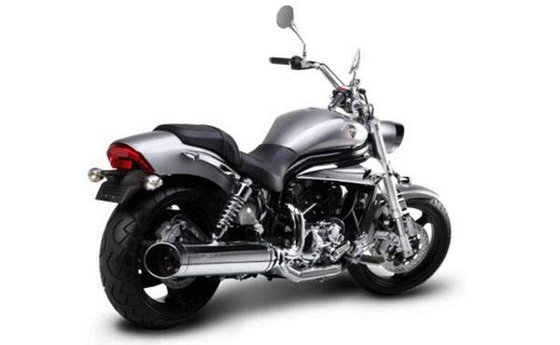
The GV 650 responds well to thoughtful upgrades:
- Exhaust: Swap the stock mufflers for a free-flowing system (with proper fuel mapping).
- Suspension: Progressive-rate springs improve front-end feedback.
- Lighting: LED headlight conversions enhance night visibility.
- Ergonomics: Adjustable rear sets from our catalog cater to taller riders.
Final Verdict
The Hyosung GV 650 isn’t just a budget alternative – it’s a legitimate contender that rewards riders who value engineering over image. While it demands more meticulous maintenance than some Japanese counterparts, the payoff is a cruiser that handles twisties with sportbike verve and growls with authentic V-twin character. For owners committed to proactive care (and judicious upgrades from MOTOPARTS.store), this Korean underdog transforms into a mile-eating companion that continually surprises.



Specifications sheet
| Engine | |
|---|---|
| Stroke: | Four-stroke |
| Max power: | 58 kW | 78.0 hp |
| Max torque: | 67 Nm |
| Fuel system: | Fuel Injection |
| Max power @: | 9000 rpm |
| Displacement: | 647 ccm |
| Max torque @: | 7250 rpm |
| Bore x stroke: | 81.5 x 62 mm (3.2 x 2.4 in) |
| Configuration: | V |
| Cooling system: | Liquid |
| Compression ratio: | 11.6:1 |
| Lubrication system: | Wet sump |
| Number of cylinders: | 2 |
| Valves per cylinder: | 4 |
| Dimensions | |
|---|---|
| Wheelbase: | 1700 mm (66.9 in) |
| Dry weight: | 232 |
| Wet weight: | 244 |
| Seat height: | 690 mm (27.2 in) |
| Overall width: | 840 mm (33.1 in) |
| Overall length: | 2431 mm (95.7 in) |
| Ground clearance: | 160 mm (6.3 in) |
| Fuel tank capacity: | 16 L (4.2 US gal) |
| Drivetrain | |
|---|---|
| Clutch: | Wet, multiplate, cable-operated |
| Final drive: | belt |
| Transmission: | 5-speed |
| Maintenance | |
|---|---|
| Engine oil: | 10W40 |
| Idle speed: | 1400–1500 rpm |
| Brake fluid: | DOT 4 |
| Spark plugs: | NGK CR8E or NGK CR8EIX |
| Spark plug gap: | 0.6 |
| Coolant capacity: | 1.6 |
| Forks oil capacity: | 0.84 |
| Engine oil capacity: | 3.2 |
| Engine oil change interval: | Every 5000 km or 2 years |
| Valve clearance (intake, cold): | 0.10–0.20 mm |
| Valve clearance check interval: | 24,000 km / 15,000 mi |
| Valve clearance (exhaust, cold): | 0.20–0.30 mm |
| Recommended tire pressure (rear): | 2.4 bar (35 psi) |
| Recommended tire pressure (front): | 2.2 bar (32 psi) |
| Chassis and Suspension | |
|---|---|
| Frame: | Steel double pipe |
| Rear tire: | 180/55-z-17 |
| Front tire: | 120/70-z-18 |
| Rear brakes: | Single 230 mm disc, 2-piston caliper |
| Front brakes: | 2 x 300 mm discs, 2-piston calipers |
| Rear suspension: | Swing arm with hydraulic double shock absorber (preload adjustable) |
| Front suspension: | 41mm USD telescopic fork (compression and rebound damping adjustable) |



